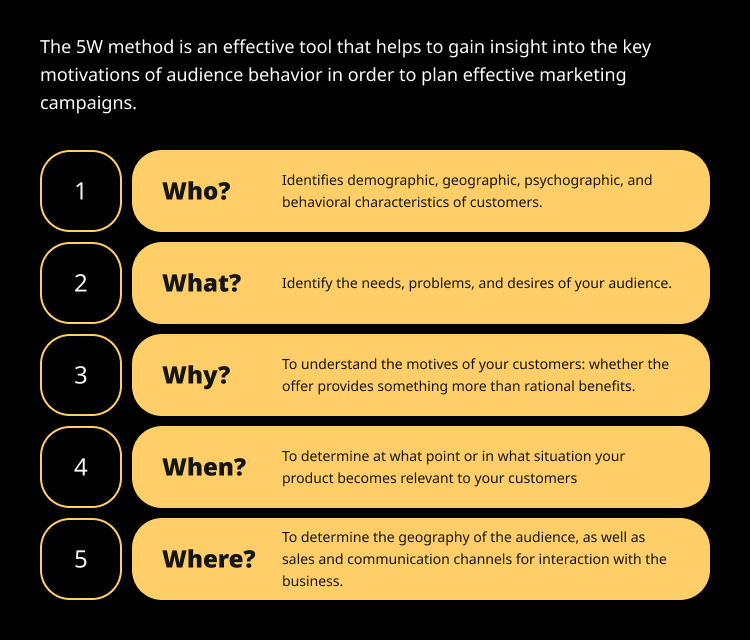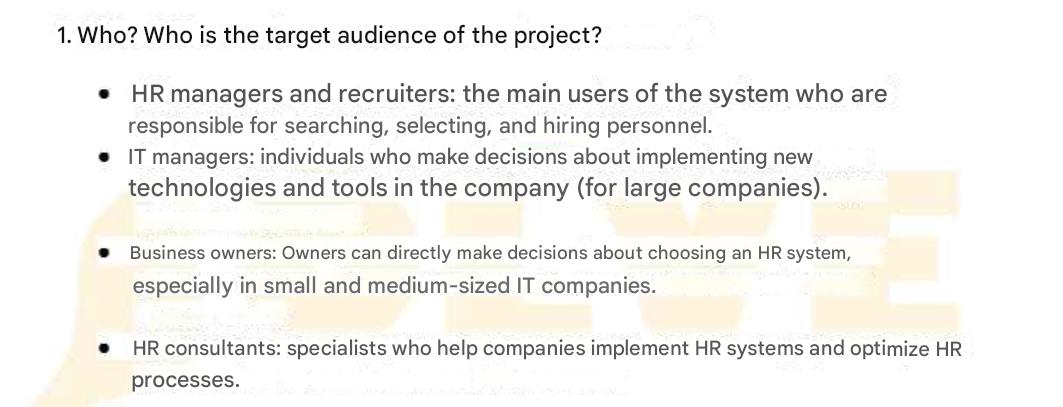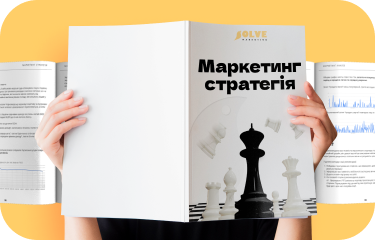12 years of developing IT solutions within our own company gradually refined our recruitment, HR, and onboarding processes.
That’s how MayBee was born — an intuitive HRM platform that brings together the needs of HR directors, recruiters, managers, and employees.
A simple interface. Full automation. Internal processes that run like clockwork.
When the platform started delivering results, a logical question arose:
“What if others need this too?”
At first, the MayBee team cautiously entered the Ukrainian market. The platform received great feedback, positive reactions, and the first sales started rolling in.
But then came the challenge — new clients were coming in, but somewhat… chaotically: through Instagram, word of mouth.
“We don’t know what exactly worked. And, even more so, we don’t know where to go from here.”
So the development team turned to us to build a predictable marketing strategy for entering international markets.
- Which market has the most potential?
- How do we identify our target audience abroad?
- How can we find our place among the giants?
That’s how our collaboration began.
| How long did it take to develop the strategy? | 150 hours, 6 working weeks |
| What is the composition of the marketing strategy development team? | Head of Marketing Team, Head of PM Team, Head of Content Team, project manager, operational marketer, SMM marketer, head of PPC department, Facebook specialist. |
| How was the result of the work used? | We started implementing the strategy as a remote marketing department. |
Starting point: the desire to scale
MayBee is an intuitive all-in-one HRM platform originally built to meet the internal needs of its team — and later launched on the Ukrainian market.
Sometimes businesses come to us with clear numbers: “We want to grow 5x, here’s the budget.”
But this team came with a request full of “maybe“, “we’ll see“, because they were just starting to bring their product to market.
We recognized a situation familiar to many SaaS products:
- The platform had strong functionality — but no clear ideas on how to sell it.
- There were case studies in Ukraine — but no international brand awareness.
- Ads were launched sporadically, social media was inconsistent.
- Feedback was positive — but there was no systematic funnel or source analytics.
- And most importantly — there was no clear understanding of the target audience.
Market research: 5 countries — 5 stories
We started with a market analysis: if you want to go on a journey, ask where each road leads. In our case, it was 5 countries: UK, Ireland, Australia, South Africa and Kazakhstan.
The UK is a market of high expectations
The HR sector has been automated here for a long time — analytics, AI, mobility, security, and flexibility. 84% of companies use HRM systems, and most of them have more than one.
But there is a nuance: half of recruiters still schedule interviews manually. This means that even in technologically mature countries, there is a niche for simple and adaptive solutions.
Insight: users are looking for products that, despite all the automation, still feel cared for and have a human touch. Even in the banking sector, where people seem to care only about numbers, Monobank has become an example of a human-centric product. In the HRM platforms segment, users are equally interested in the assurance that the system is designed with care for the people who use it. And that at any time someone smart and friendly is ready to help.
Ireland — a market for balance and well-being
Companies are implementing EAP programs, automating HR, and looking not just for functionality — but for philosophy. This is a market where emotional intelligence in a product is worth just as much as the technology behind it.
➡️ That’s when our hypothesis solidified: a platform focused on people, with intuitive design and clear support — is exactly what Irish HR professionals are looking for.
Australia — a market of strict rules and flexible companies
Here, HRM systems are a way to survive under strict legislation. Constant changes in requirements for recordkeeping, leave policies, safety, and employee mental health are the norm.
But there’s a paradox: the market is hot, yet Google search demand is unstable. That’s why direct communication, local integrators, and rapid adaptation to changes are key.
Insight: each country we studied had its own unique choice factors, in addition to the common ones. For example, an HRM platform can successfully compete in the Australian market if it emphasises compliance with WHS standards and adaptability.
The markets of South Africa and Kazakhstan had their own unique characteristics. We gained a sense of each market’s personality and realized that a one-size-fits-all communication strategy wouldn’t work across all five. But the client’s final choice will remain behind the scenes of this case.
When decisions are based on guesswork, growth becomes random. Do you want to know where the potential really lies?
Competitors: the life of giants
We conducted a comprehensive competitor analysis using the “3 circles of influence” model:
- Functionality & UX: what exactly competitors offer, how user-friendly and adaptive their platforms are.
- Promotion & positioning: how they present themselves, what emotions they evoke.
- Actual behavior & customer interaction: through analysis of social media, websites, and “mystery shopper” research.
What did we see from the competitor analysis?
There are many famous names on the market. They are big and well-known. But they are often complex, slow, or far from the real needs of the team.
We realised one thing:
Businesses don’t always need “heavy artillery”. They often need a partner who is flexible, intuitive, and fast. That’s exactly what MayBee is.
Insight: a well-known brand works as a trust factor, but businesses often need a partner with whom they can simply communicate their needs and expectations. And to hear the response of a real person who really values this relationship.
It’s the same in marketing. If you’re looking for a partner who will take care of this relationship, a remote marketing department is the best option.
“Mystery shopper”
During the “mystery shopper” research, we went through the full sales funnels of several competitors. Here’s what we discovered:
- Some companies didn’t respond at all to demo requests.
- Registration was confusing, with too many unnecessary steps.
- Promises made during sales communication were often not fulfilled.
Insight: large companies have no shortage of inquiries, so they can afford to shift onboarding efforts to the client, with the risk of losing most of them and not bringing them to a purchase. In contrast, we can create a simple onboarding funnel, warm first communication, useful content, and become “ours” for the client from the first minute.
That is why we decided to build marketing not around the number of functions, but around the human experience.
Understanding not only WHO they are, but also HOW they think
In addition to in-depth analysis of markets and competitors, you should ask yourself the question:
“Who is the person who will order the demo?”
Who is our target audience?
We segmented the audience using the 5W method.

We identified four key segments and also described:
- What are they interested in?
- Where can we find them?
- When are they ready to make a decision?
- Why will they choose our product?
Part of the analysis:
What is important to them?
Every client has their own decision-making logic. That’s why we at Solve Marketing developed the choice factors framework.
This approach helps you clearly understand why clients buy, what influences their decisions, and how to adapt your marketing strategy so that those decisions work in your favor.

In a competitive environment, it’s crucial to communicate your value in the way the client wants to hear it. That’s where the key factors influencing the buyer’s decision come into play.
We identified 120+ choice factors that:
- Determine which elements have the greatest influence in this specific industry.
- Benchmark the company against key competitors.
- Form clear tasks for business growth and development.
- Make it possible to turn weaknesses into competitive advantages.
Learn more about our framework and examples of implementation here.
Positioning
There are products that shout: “We have 147 features! We integrate with everything that exists!”
And then there are others — reserved, strict, corporate. So which is right?
The key is not to invent positioning, but to listen — in the voices of HR directors, in the feedback from recruiters who work with the platform.
During the competitor analysis, we kept seeing the same pattern:
- complex timelines;
- long implementation processes;
- state-of-the-art design without a soul;
- platforms that talk but don’t listen.
Therefore, after analyzing competitor positioning and the collected choice factors, we developed four positioning concepts — each of which underwent a rigorous crash test with the client’s team.
Following the discussions, we and the client approved the following version:
MayBee is an HR process automation platform that lets one person handle the work of an entire department.
Positioning is not just a catchy phrase — it’s the foundation of your communication strategy. For it to truly become part of your company and be subconsciously picked up by clients, the core idea and concept must be conveyed through different touchpoints:
- On the website: use simple CTAs, conversational language, and avoid generic phrases.
- In SMM: show real videos of an HR manager setting up the system in 15 minutes.
- In ads: create scenarios from real life — vacation requests, equipment orders, training — all managed in one platform.
Here’s more on how positioning actually works.
We will help you formulate the message that will make your client’s choice obviously in your favour. Sign up for a free consultation.
Marketing strategy: launching test lead generation
Before the test launch, we conducted a full audit of Google and Meta accounts. We found out that the campaigns were working, but the budget was being spent inefficiently due to the specifics of the settings.
We structured all the problems, formed a new campaign logic, and gave clear recommendations. This allowed us to prepare the platform for an effective test launch.
Building a strategy: from funnels to channels
We worked with the See–Think–Do–Care framework and built a separate funnel for each stage in Google, Meta, and LinkedIn Ads. But the most important part was crafting the right offers and messages that effectively segmented the audiences.
Insight: don’t expect just one lead generation channel to bring in customers. In complex niches with long decision-making cycles, it sometimes takes up to 12 “touches” with a customer before they decide to take the first step and move on to action.
What’s the result?
The MayBee team came to us with a request for growth, but without clear answers to “where”, “how” and “to whom”. We started with an in-depth analysis of the market, competitors, funnels, and customer behaviour, and managed to turn uncertainty into a clear strategy.
We managed to embed a sense of trust, clear communication, and humanity at the core of the project’s marketing.
MayBee is ready to scale. Now they know where, with whom, and how.
🔸 Want to launch your product internationally but don’t know where to start?
🔸 Have strong functionality but weak positioning?
🔸 Need a strategy that’s not just about marketing, but about growth?
Sign up for a consultation — and we’ll help you reach results faster and with lower costs.







